After a six-year hiatus, Chicago was once again host in 2012 to an international art fair, Expo Chicago. The event was held September 20-23 in the massive Festival Hall at Navy Pier, a tourist destination near the city’s center. One hundred galleries exhibited work in the fair, presenting enough material to easily fill up a day of viewing. Such a presentation offered a unique opportunity to survey the world of contemporary art—and, specifically, its problems and possibilities.
Painting and photography were most widely represented at Expo Chicago, followed by sculpture, drawing and new media.
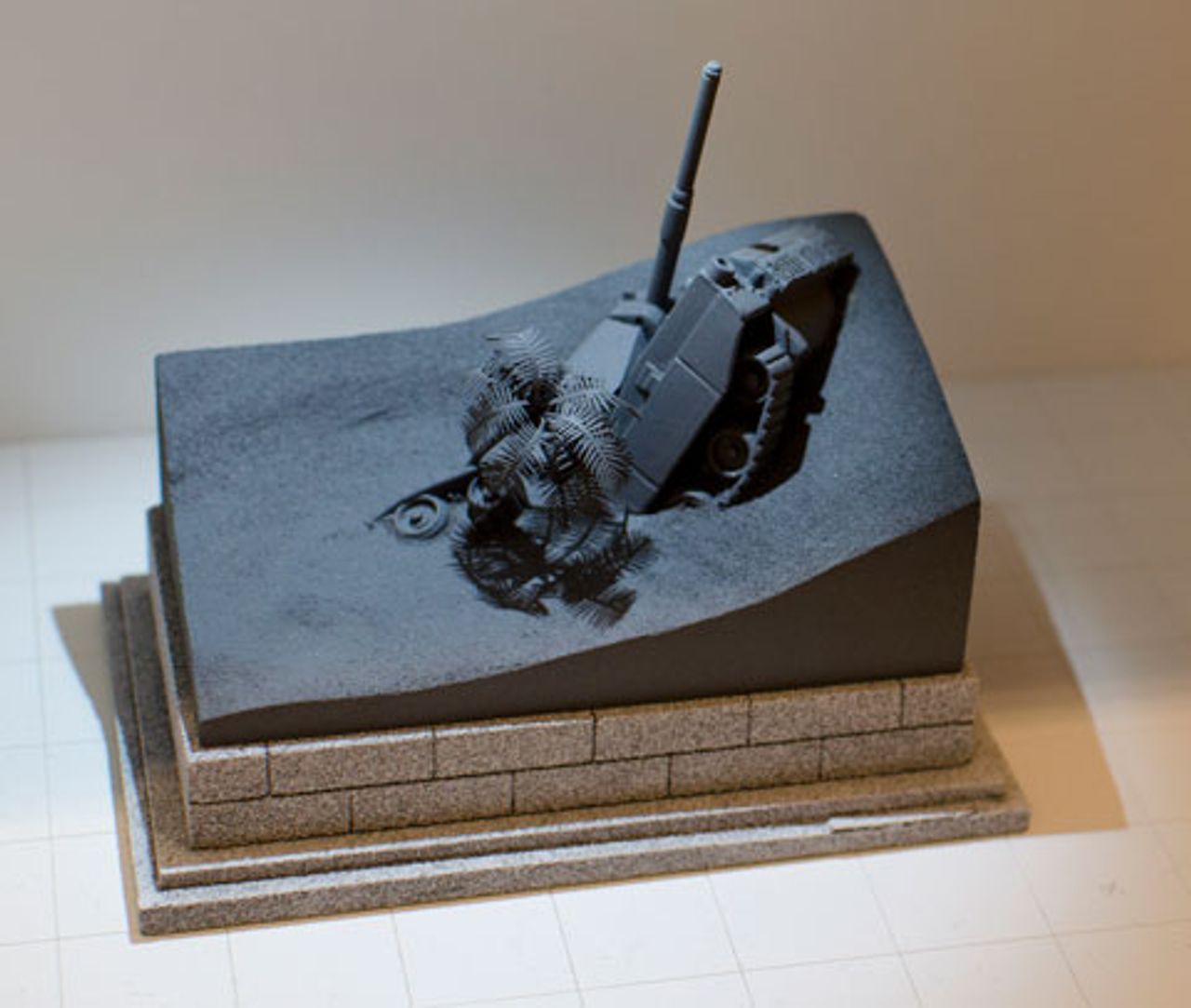 David Opdyke
David OpdykeMonumental Failures
Carved and milled urethane, styrene
Two traits quickly made themselves felt. First of all, there is an exciting, seemingly boundless availability of media and formats for artists to work in, including relatively new technologies such as 3D printing (the making of solid objects by adding layers of material), projection and bold methods of material fabrication. In itself, however, this variety of media does not automatically lead to artistically significant or emotionally engaging content.
Secondly, the fair was awash in money, and the brazen commodification of art and the consequences of that process are readily apparent. A substantial amount of artwork is almost insignificant in either its mediocrity or inaccessibility, or both. Some works seem immediately destined for life as decoration in homes or offices, and only the dizzying price tags separate such efforts from the kitsch one finds in a shopping mall gallery.
Thankfully, amid the flurry of commerce and triviality, there is still thoughtful, compelling and fascinating work to be found—although relative to current social and political developments, it seems a pale reflection of life as it is for millions across the world. That said, these are some of the works and artists that stood out.
Works of note
Monumental Failures is a witty, attractive series of small sculptures by the prolific artist David Opdyke, presented by the Bryce Wolkowitz Gallery. Each of the 24 pieces features a model-like, finely detailed, grey subject set on a textured tombstone. The Capitol dome, instruments of war old and new, a house, a pipeline, a parking lot and a symbolic eagle are shown to have met their deaths, suggesting each is a relic of history, even as it persists in the present day.
Also on display were a few of the fascinating photographs of industrial processes, nature and economic life by Edward Burtynsky. His decades-long body of work features photographs from around the world offering grand views of monumental subjects—from massive mines in North America to seemingly endless factory floors in China. Those are accompanied by portraits of harrowing working conditions (shipbreaking in Bangladesh) and disturbing environmental effects (mine tailings).
On display from the Forum Gallery were two sculptures combining religion and weapons by California artist Al Farrow. Mezuzah #10 presents a bullet with a kosher scroll of text within, while Revelation I, from 2004, depicts a classic American church. At first glance, guns as structural components are obvious, but close inspection reveals the entire scene—walls, floor, roof and all—to be composed of either gun parts, bullets or bone. The stained, worn character of the piece hits at a longstanding, deep connection between religion and war....
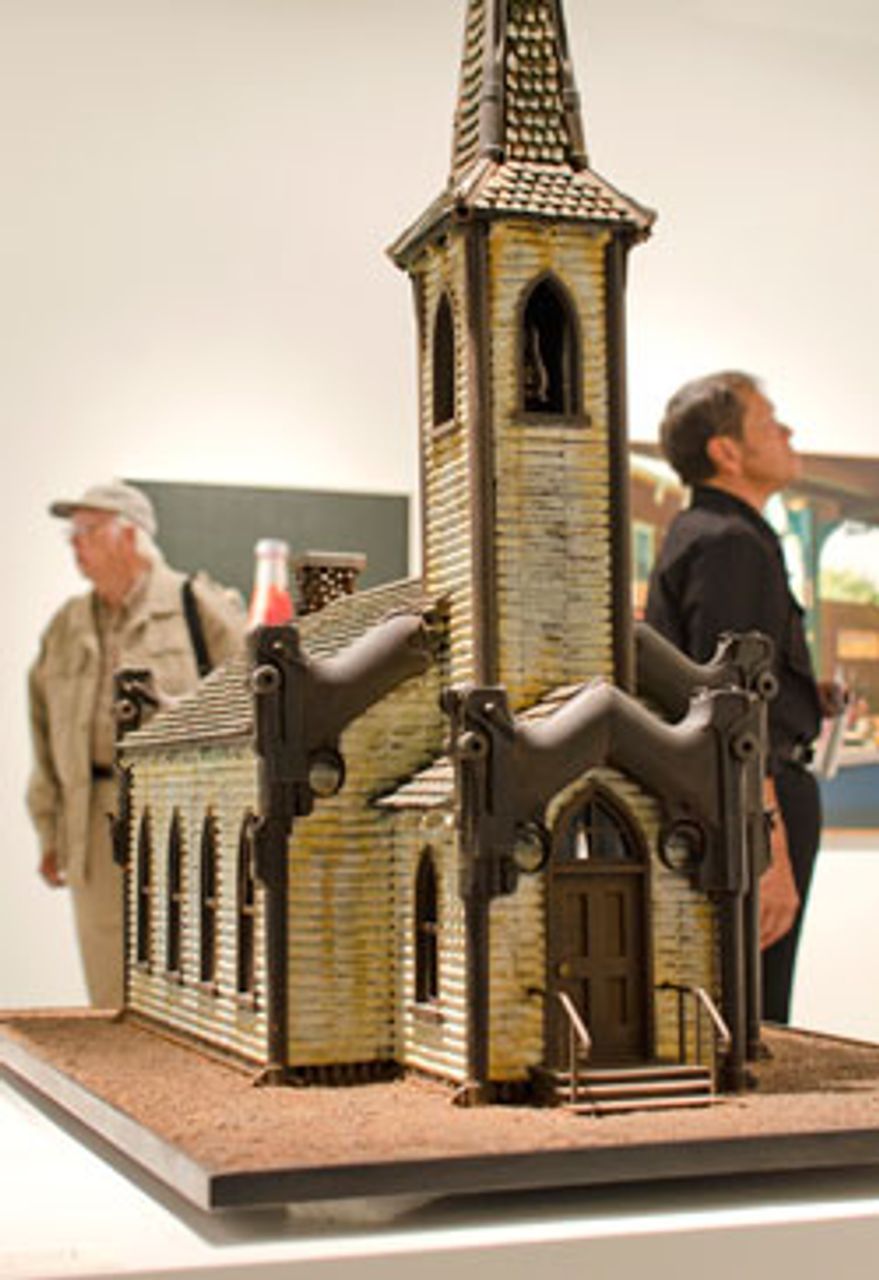 Al Farrow
Al FarrowRevelation (I)
Gun Parts, Bullets, Bone
Poverty and social inequality, those great unmentionables in America, were uncommon as subject matter at Expo Chicago. Perhaps the most open treatment of them was on display at the Steven Wirtz Gallery, which offered several large, hazy, color photo prints by Doug Rickard. The prints are from the series A New American Photography, into which Rickard undoubtedly put an enormous amount of time researching the most devastated regions of the United States and then scouring the Google Street View database to extract images, often featuring figures.
The resulting scenes show countless regions of distress that the artist suggests otherwise go unseen, but with the complication that no photo involves a connection between photographer and subject. Figures are essentially anonymous, yet Rickard apparently seeks to continue the tradition of renowned photographers of the Great Depression, like Walker Evans, or the postwar era, such as Robert Frank. The artist considers the use of digital technology and the Internet an inevitable expression of changes in social life, but that does not overcome the problem of the photos having none of the immediacy and emotional impact of the work of those earlier figures. Ironically, Rickard’s work keeps poverty at a distance, a vague subject within the generally well-heeled environs of the gallery world.
By contrast, nearby hung the deeply human portraits of photographer Dawoud Bey. A Boy in Front of the Loews 125th Street, from 1976, shows a sharply dressed boy striking a confident pose outside a movie theater—yet he is on tiptoes to achieve the pose. The large Couple in Prospect Park, an image of two teenagers embracing, exudes warmth, beauty and optimism.
Artist Lauren Adams, working with the Contemporary Art Museum St. Louis, presented the installation We the People, perhaps the most overtly political commentary on display. Three walls of seductive patterned blue wallpaper, reproduced from the Revolutionary War era, have signs within the pattern bearing carefully hand-painted slogans from both Occupy Wall Street and Tea Party protests, functioning as a “generalized call to action” and reflection of the anger and tension in American society, some of it finding quite a reactionary outlet.
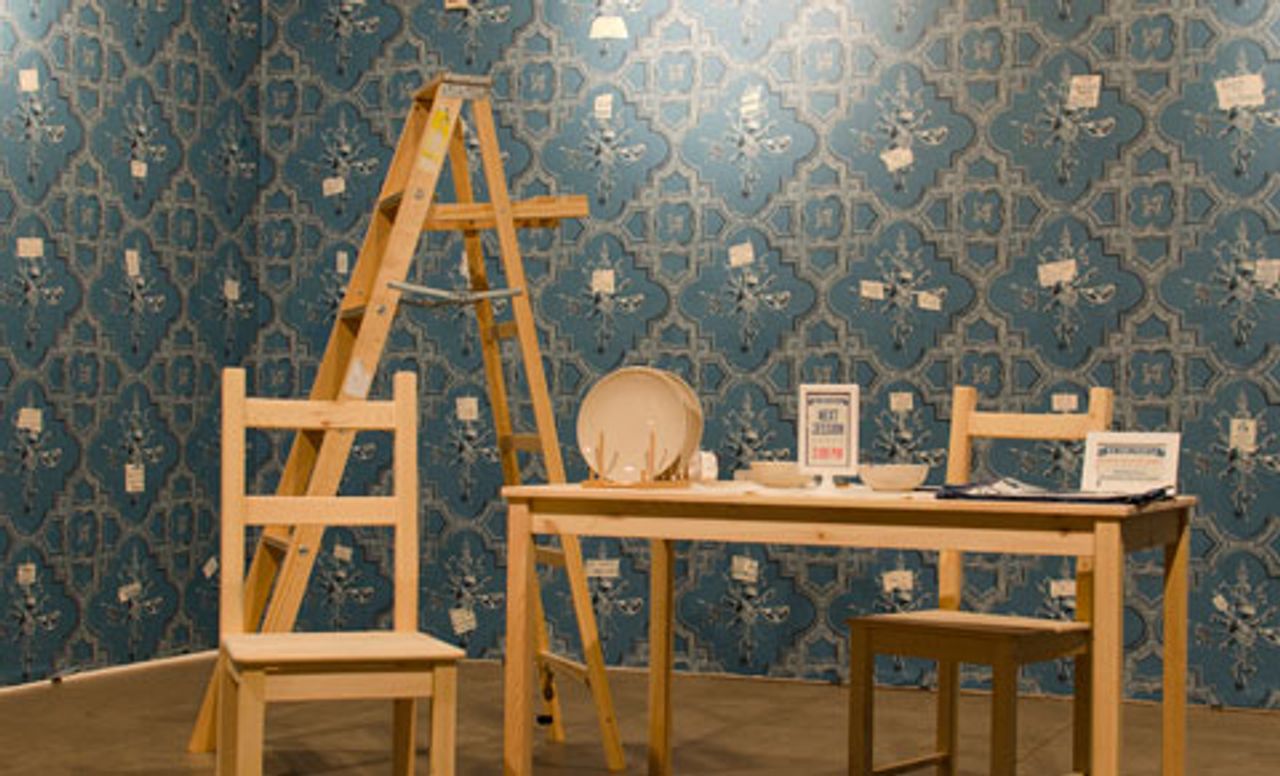 Lauren Adams
Lauren AdamsWe the People
overview
A rare sense of life as it is for millions in America pervades the vibrant realist paintings of Tom Birkner, shown by Paul Thiebaud Gallery. Certain everyday items, scenes, clothing, events and especially facial expressions are presented beautifully and not without humor in the paintings. The New Jersey-born Birkner features working class life prominently, and what could be a stereotype—for example, youth in classic autos—is tempered by another image showing someone trying to repair a beat-up car.
For some contemporary artists, success seems to bring with it a conservatism in form, so that whatever “worked” is then reproduced, with slight variations, dozens or even hundreds of times. The diverse drawing, painting and printmaking of Nicole Eisenman, on display at Leo Koenig, Inc., offered a welcome variety, as the artist clearly seeks out whatever form fits her intent.
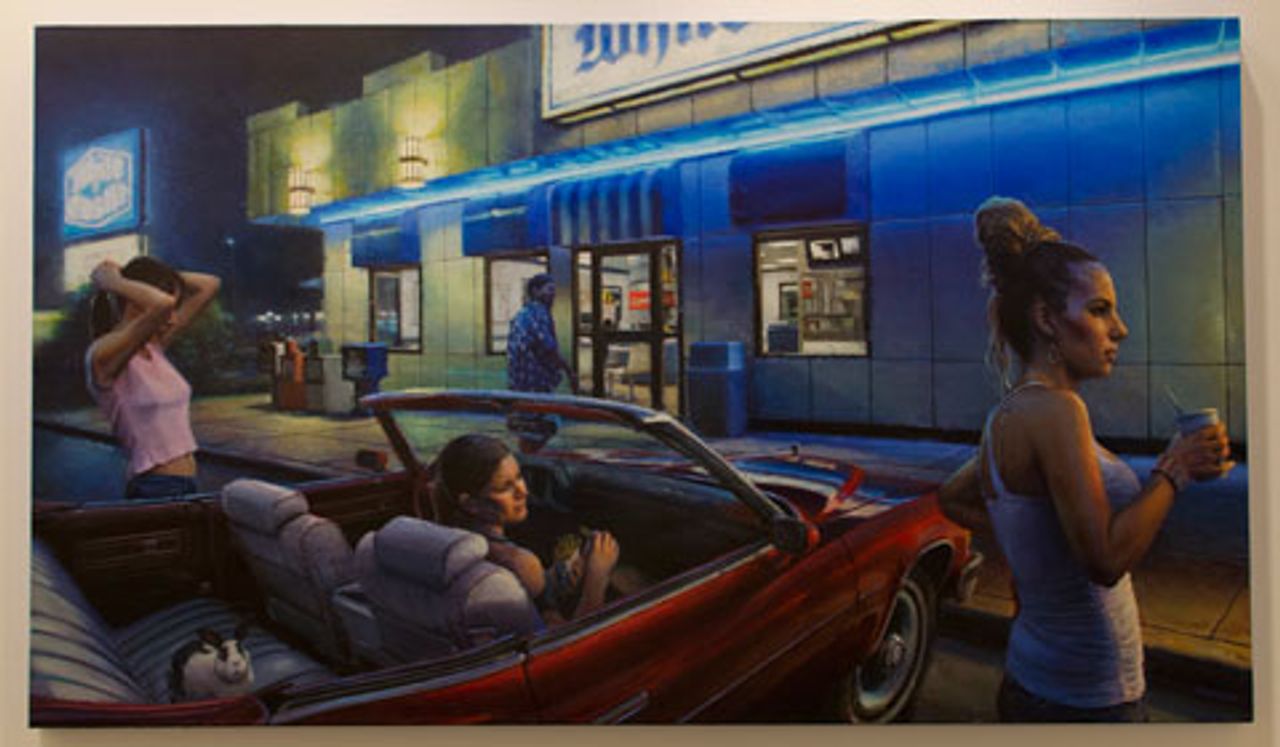 Tom Birkner
Tom BirknerScene at White Castle
oil on canvas 42 ¼ x 72 5/8 in.
One of her more forceful images is a large, two-color stone lithograph in which a man with a Revolutionary War hat and grimace on his face is handing a scythe, miniature US flag and pineapple attached, to a skeleton. A businessman joins in as well, and the skeleton seems to be accepting the object cheerfully.
Elsewhere there were political works of a simple, slogan-like character that seriously limit reflection. Choice, for instance, by conceptual artist Michele Pred, presents 1,400 pink birth control pills spelling out the word “choice.” Other recent work by the artist is described as a response to the right-wing assault on reproductive rights, but nothing about why there is such an attack seems addressed by the works.
The Atmosphere
The late critic Robert Hughes said, “Apart from drugs, art is the biggest unregulated market in the world.” The pernicious influence of large quantities of money was readily apparent at Expo Chicago. Even before stepping in the hall, one passed a $135,000 roadster by official sponsor Mercedes Benz. Once inside, the prices of the artwork ranged from the thousands of dollars to $25 million for a Picasso painting surrounded by round-the-clock security.
On several occasions, I spoke to a gallery owner or assistant to find out more about a work that aroused my curiosity, but received no substantial reply. I was told in some cases that the artist’s intent was entirely mysterious. Paris’s Galerie Gabrielle Maubrie showed several works by Brazilian artist Nelson Leirner consisting of stickers of cartoon characters on top of maps from atlases. Each country, or continent, was filled to the brim with Mickey Mouse, Dora the Explorer, etc. Asked about the use of the stickers, a representative struggled for a moment, then said the works were “about the world.” The price was somewhat otherworldly, $20,000 per map.
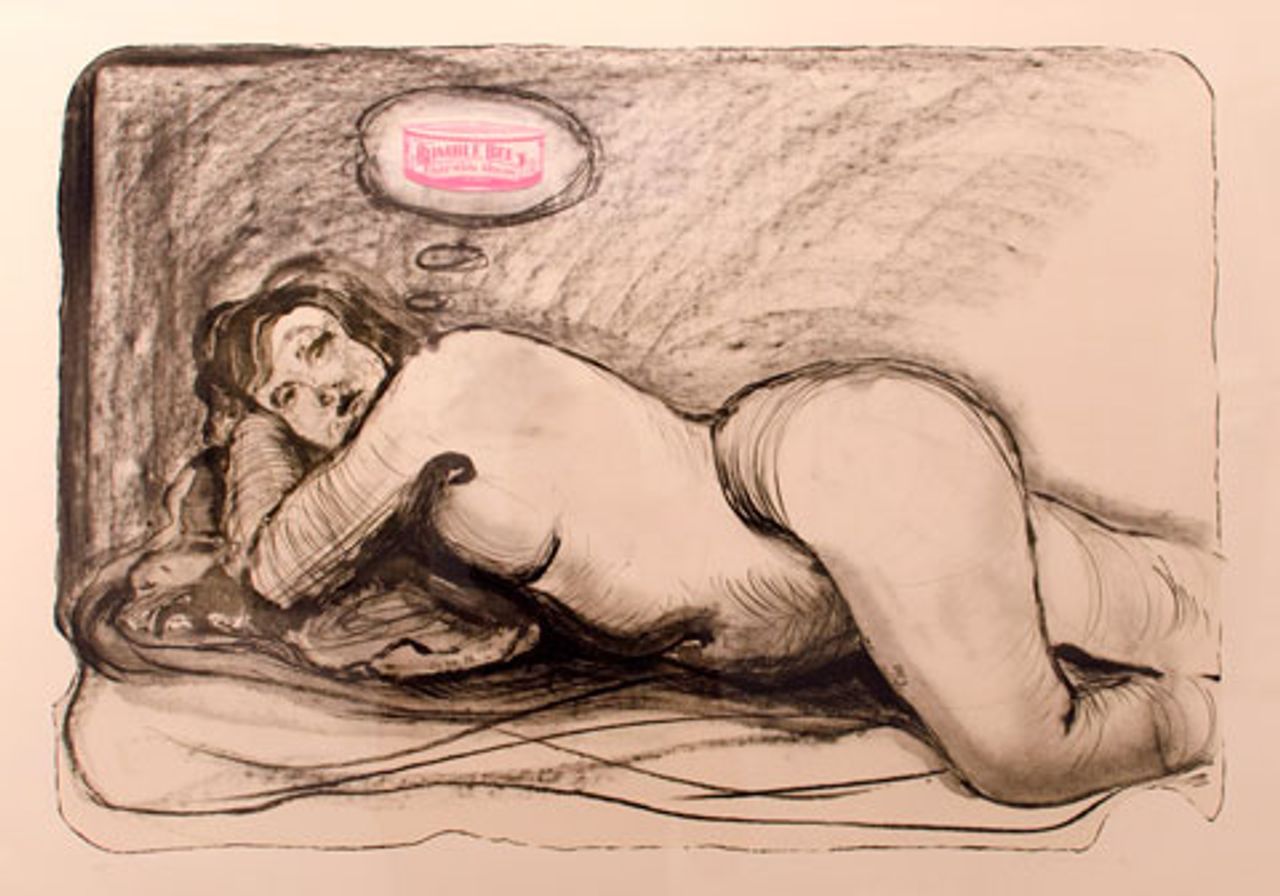 Nicole Eisenman
Nicole EisenmanThe Thinker
2012
Graphite and collage on paper
Image size: 19.5 × 28.25 in.
Two works were actually made out of cash. Narrow Reaper and Huge Poodle, by former tattoo artist Scott Campbell, consist of sheets of dollar bills laser cut into the shape of a grim reaper and a poodle, respectively. Appropriately enough, as I approached the works, a dealer was attempting to close a sale. The following short dialogue ensued. Dealer: “That one [Huge Poodle] is $45,000, while that one [Narrow Reaper] is $25,000.” Customer: “But the poodle looks easier than the reaper.... Well, the poodle is great, something to talk about with my clients when they come into the office; they are already scared to death about money. What about the Chicago sales tax?”
Campbell has many more of these money reliefs, if they can be called that, featuring a teddy bear, a gun, a skull and many typical tattoo visuals. If there were any ambiguity about whether social commentary might lurk behind his use of money, Campbell clarified to Details magazine that “I try not to get political with artwork. For me, it’s more that primal, emotional reaction people have with money. It’s the first thing people think about when they wake up, whether they realize that or not—it’s the reason why they get out of bed.”
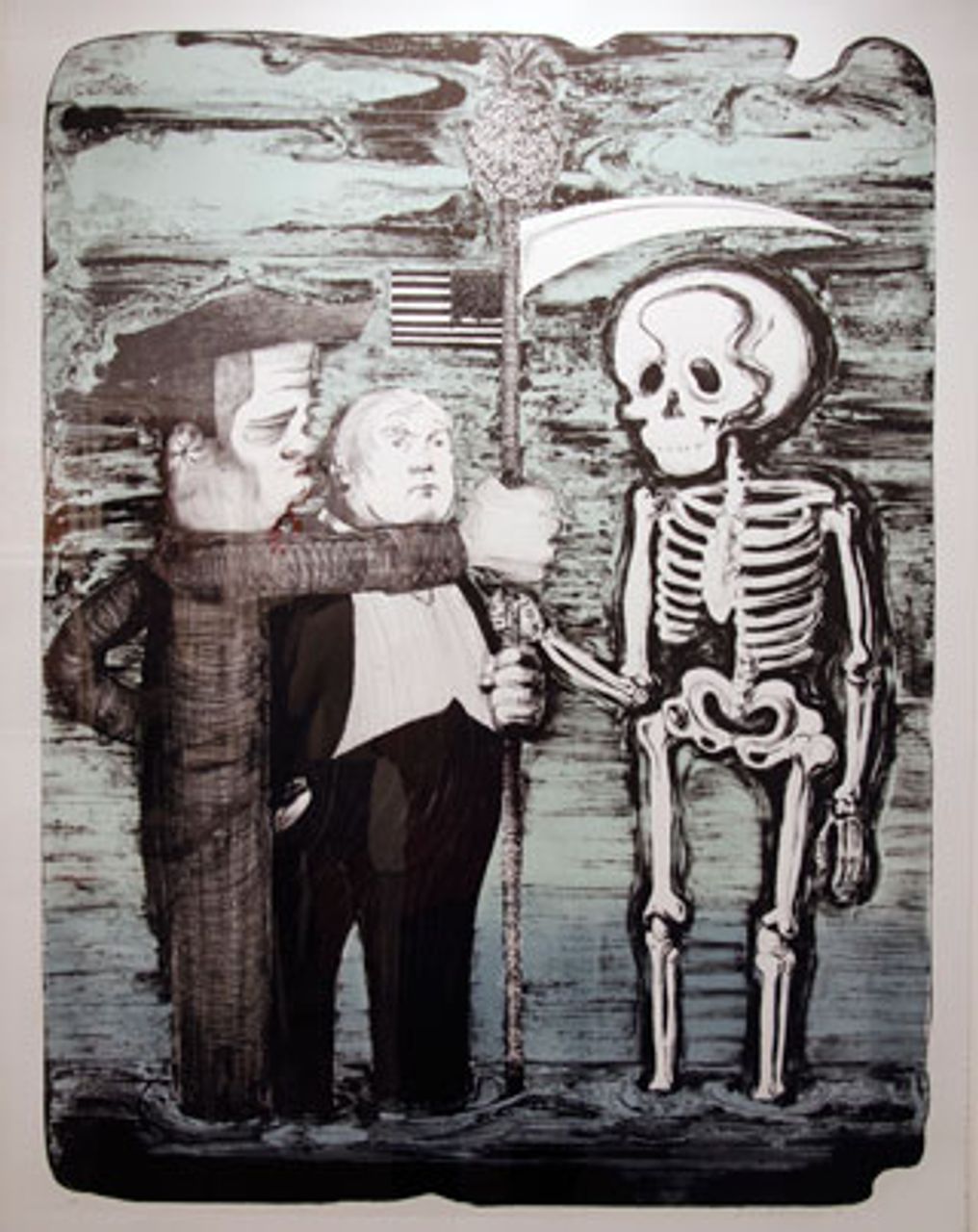 Nicole Eisenman
Nicole EisenmanTea Party
2012
2-color lithograph
Image size: 32 × 22 1/2 in.
Fortunately, other artists have somewhat higher conceptions of humanity and its potential.
The insularity of the official art world stems from many factors, including historical and ideological ones. Certainly, the sums of money involved and the wide gap between artist and potential audience, the result of both the effect of the market and social pressures on certain artists, on the one hand, and the cultural impoverishment of the population, on the other, play a major role. Technical challenges, however, have certainly diminished. Images and video are instantly accessible to the entire world—although how an artist can make a living at present in such media is less clear.
With that in mind, it is frustrating to come upon works only partially revealed in a gallery setting. For example, Galerie Lelong featured still photographs of performances by Cameroonian artist Barthélémy Toguo—but the photographs are not the work, Toguo’s performances are, and where can one find those? Or, many video artists “edition” videos to make them into objects that galleries can sell, but that often depends on removing any other public access to the videos (aside from the given gallery) at a time when the public can access millions of videos, instantly, online.
Talent and skill were not hard to find at Expo Chicago, but the conscious and insightful application of that talent and skill—to what degree they spoke to the thoughts, concerns and imagination of the public—was something far rarer.
